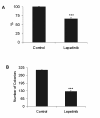Antitumor and antiangiogenic effect of the dual EGFR and HER-2 tyrosine kinase inhibitor lapatinib in a lung cancer model
- PMID: 20459769
- PMCID: PMC2883966
- DOI: 10.1186/1471-2407-10-188
Antitumor and antiangiogenic effect of the dual EGFR and HER-2 tyrosine kinase inhibitor lapatinib in a lung cancer model
Abstract
Background: There is strong evidence demonstrating that activation of epidermal growth factor receptors (EGFRs) leads to tumor growth, progression, invasion and metastasis. Erlotinib and gefitinib, two EGFR-targeted agents, have been shown to be relevant drugs for lung cancer treatment. Recent studies demonstrate that lapatinib, a dual tyrosine kinase inhibitor of EGFR and HER-2 receptors, is clinically effective against HER-2-overexpressing metastatic breast cancer. In this report, we investigated the activity of lapatinib against non-small cell lung cancer (NSCLC).
Methods: We selected the lung cancer cell line A549, which harbors genomic amplification of EGFR and HER-2. Proliferation, cell cycle analysis, clonogenic assays, and signaling cascade analyses (by western blot) were performed in vitro. In vivo experiments with A549 cells xenotransplanted into nude mice treated with lapatinib (with or without radiotherapy) were also carried out.
Results: Lapatinib dramatically reduced cell proliferation (P < 0.0001), DNA synthesis (P < 0.006), and colony formation capacity (P < 0.0001) in A549 cells in vitro. Furthermore, lapatinib induced G1 cell cycle arrest (P < 0.0001) and apoptotic cell death (P < 0.0006) and reduced cyclin A and B1 levels, which are regulators of S and G2/M cell cycle stages, respectively. Stimulation of apoptosis in lapatinib-treated A549 cells was correlated with increased cleaved PARP, active caspase-3, and proapoptotic Bak-1 levels, and reduction in the antiapoptotic IAP-2 and Bcl-xL protein levels. We also demonstrate that lapatinib altered EGFR/HER-2 signaling pathways reducing p-EGFR, p-HER-2, p-ERK1/2, p-AKT, c-Myc and PCNA levels. In vivo experiments revealed that A549 tumor-bearing mice treated with lapatinib had significantly less active tumors (as assessed by PET analysis) (P < 0.04) and smaller in size than controls. In addition, tumors from lapatinib-treated mice showed a dramatic reduction in angiogenesis (P < 0.0001).
Conclusion: Overall, these data suggest that lapatinib may be a clinically useful agent for the treatment of lung cancer.
Figures








Similar articles
-
Antitumor activity of a dual epidermal growth factor receptor and ErbB2 kinase inhibitor MP-412 (AV-412) in mouse xenograft models.Cancer Sci. 2009 Aug;100(8):1526-31. doi: 10.1111/j.1349-7006.2009.01197.x. Epub 2009 May 13. Cancer Sci. 2009. PMID: 19459856 Free PMC article.
-
The HDAC inhibitor, MPT0E028, enhances erlotinib-induced cell death in EGFR-TKI-resistant NSCLC cells.Cell Death Dis. 2013 Sep 19;4(9):e810. doi: 10.1038/cddis.2013.330. Cell Death Dis. 2013. PMID: 24052078 Free PMC article.
-
Anti-tumor activity of high-dose EGFR tyrosine kinase inhibitor and sequential docetaxel in wild type EGFR non-small cell lung cancer cell nude mouse xenografts.Oncotarget. 2017 Feb 7;8(6):9134-9143. doi: 10.18632/oncotarget.13327. Oncotarget. 2017. PMID: 27852073 Free PMC article.
-
An update on molecularly targeted therapies in second- and third-line treatment in non-small cell lung cancer: focus on EGFR inhibitors and anti-angiogenic agents.Clin Transl Oncol. 2013 May;15(5):343-57. doi: 10.1007/s12094-012-0964-2. Epub 2013 Jan 29. Clin Transl Oncol. 2013. PMID: 23359171 Review.
-
Circulating endothelial and endothelial progenitor cells in non-small-cell lung cancer.Clin Transl Oncol. 2010 Aug;12(8):521-5. doi: 10.1007/s12094-010-0549-x. Clin Transl Oncol. 2010. PMID: 20709649 Review.
Cited by
-
Validation of diverse and previously untraceable Sendai virus copyback viral genomes by direct RNA sequencing.J Virol. 2025 Aug 19;99(8):e0089425. doi: 10.1128/jvi.00894-25. Epub 2025 Jul 31. J Virol. 2025. PMID: 40742273 Free PMC article.
-
Sequential application of anticancer drugs enhances cell death by rewiring apoptotic signaling networks.Cell. 2012 May 11;149(4):780-94. doi: 10.1016/j.cell.2012.03.031. Cell. 2012. PMID: 22579283 Free PMC article.
-
FOXO3a represses VEGF expression through FOXM1-dependent and -independent mechanisms in breast cancer.Oncogene. 2012 Apr 5;31(14):1845-58. doi: 10.1038/onc.2011.368. Epub 2011 Aug 22. Oncogene. 2012. PMID: 21860419 Free PMC article.
-
Human epidermal growth factor receptor bispecific ligand trap RB200: abrogation of collagen-induced arthritis in combination with tumour necrosis factor blockade.Arthritis Res Ther. 2011;13(5):R161. doi: 10.1186/ar3480. Epub 2011 Oct 7. Arthritis Res Ther. 2011. PMID: 21982514 Free PMC article.
-
Mapping the FGF2 Interactome Identifies a Functional Proteoglycan Coreceptor.ACS Chem Biol. 2025 Jan 17;20(1):105-116. doi: 10.1021/acschembio.4c00475. Epub 2024 Dec 20. ACS Chem Biol. 2025. PMID: 39704408 Free PMC article.
References
-
- Pajares MJ, Zudaire I, Lozano MD, Agorreta J, Bastarrika G, Torre W, Remirez A, Pio R, Zulueta JJ, Montuenga LM. Molecular profiling of computed tomography screen-detected lung nodules shows multiple malignant features. Cancer Epidemiol Biomarkers Prev. 2006;15:373–380. doi: 10.1158/1055-9965.EPI-05-0320. - DOI - PubMed
-
- Rosell R, Moran T, Queralt C, Porta R, Cardenal F, Camps C, Majem M, Lopez-Vivanco G, Isla D, Provencio M, Insa A, Massuti B, Gonzalez-Larriba JL, Paz-Ares L, Bover I, Garcia-Campelo R, Moreno MA, Catot S, Rolfo C, Reguart N, Palmero R, Sánchez JM, Bastus R, Mayo C, Bertran-Alamillo J, Molina MA, Sanchez JJ, Taron M. Screening for epidermal growth factor receptor mutations in lung cancer. N Engl J Med. 2009;361:958–967. doi: 10.1056/NEJMoa0904554. - DOI - PubMed
-
- Rocha-Lima CM, Soares HP, Raez LE, Singal R. EGFR targeting of solid tumors. Cancer Control. 2007;14:295–304. - PubMed
Publication types
MeSH terms
Substances
LinkOut - more resources
Full Text Sources
Other Literature Sources
Medical
Research Materials
Miscellaneous

